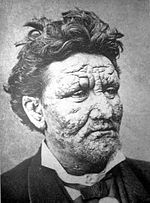Lepera
Lepera, le tsejwang hape ka hore ke bolwetse ba Hansen (HD), ke tshwaentso ya nako e telele e bakuweng ke baktheria ya Mycobacterium leprae[1] le Mycobacterium lepromatosis.[2] Ho tloha qalong, ditshwaetso ha di na matshwao a ho kula mme di kanna tsa dula di le jwalo ho tloha dilemong tse 5 ho isa ho tse 20.[1] Matshwao a ho kula a hlahang a kenyeletsa ho ruruha ho honnyane ha bokantle ba methapo ya boko/methapokutlo, peipi ya ho hema, letlalo, le mahlo.[1] Ho qetella ka ho se utlwe bohloko dithong tsa mmele mme hoo ho ka lebisa tahlehelong ya ditho tsa mmele ka lebaka la ho tswa dikotsi kgafetsa kapa tshwaetso e bakwang ke maqeba a sa elweng hloko.[3] Bofokodi le kgaello ya pono di kanna tsa ba teng.[3]
| Lepera | |
|---|---|
| Tlhophiso le mehlaodi ya kantle | |
 | |
| ICD/CIM-10 | A30 A30 |
| ICD/CIM-9 | 030 030 |
| OMIM | 246300 |
| DiseasesDB | 8478 |
| MedlinePlus | 001347 |
Lepara le nama mahareng a batho. Ho kgolwa hore le ka etsahala ka ho kgohlola kapa ho ama lero le tswang nkong ya motho ya tshwaeditsweng.[4] Lepera le hlaha hangata hara batho ba futsanehileng mme ho dumelwa hore le ka fetiswa ka marothodi a hlahang ho hemeng.[3] Ho fapana le mohopolo o tlwaelehileng, ha le tshwaetse haholo ka ho ama.[3] Mefuta e mmedi ya sehlooho ya bolwetse bona e itshetlehile palong e teng ya baktheria: paucibacillary (sehlotshwana se itseng sa dibaktheria) le multibacillary (boiyane ba dibaktheria).[3] Mefuta e e mmedi e arolwa ka palo ya ya motswako wa mmala wa letlalo, palo ya ditlapedi tse letlalong, e nang le dihlotshwana tse hlano kapa tse ka tlase le boiyane bo fetang bohlano.[3] Tlhahlobo ya ho kula e tiiswa ka ho etsa teko sekgohleleng ka laboratoring sekotwaneng sa letlalo sa setho sa mmele kapa ho hlahloba DNA ho sebediswa mokgwa o bitswang polymerase chain reaction.[3]
Lepera le ka phekolwa ka kalafo e bitswang multidrug therapy (MDT).[1] Kalafo bakeng sa lepera la paucibacillary ke ka meriana ya dapsone le rifampicin nako ya dikgwedi tse tsheletseng.[3] Kalafo bakeng sa lepera la multibacillary ke ka meriana ya rifampicin, dapsone, le dofazimine nako ya dikgwedi tse leshome le metso e mmedi.[3] Dikalafo tsena di fuwa mahala ke Mokgatlo wa Lefatshe wa Bophelo bo Botle.[1] Palo e nngwe ya dilwantshadikokwanahloko e kanna ya sebediswa.[3] Lefatshe ka bophara ka 2012, palo ya diketsahalo tsa lefu la nako e telele ya lepera e ne e le 189,000 e theohile ho tloha ho dimilione tse 5.2 dilemong tsa bo-1980.[1][5][6] Palo ya diketsahalo tse ntjha e ne e le 230,000.[1] Boholo ba diketsahalo tse ntjha di etsahetse dinaheng tse 16, moo India e neng e na le palo e fetang halofo ya palo e boletsweng.[1][3] Dilemo tse 20 tse fetileng, dimilione tse 16 tsa batho lefatshe ka bophara ba ile ba phekolwa lepera.[1] Diketsahalo tse 200 di tlalehwa Dinaheng tse Kopaneng tsa Amerika ka selemo.[7]
Lepara le amme batho dilemo tse diketekete.[3] Bolwetse bona bo fumane lebitso la bona ho tswa ho Selatini lentswe lepra, le bolelang "lekgekgefa", ha lereo lena "Hanse's disease" le reheletswe ngaka Gerhard Armauer Hansen.[3] Ho kgetholla batho le ho ba beha ditsheng tsa balepera ho ntse ho etsahala dibakeng tse jwaloka India[8], China[9], le Afrika.[10] Leha ho le jwalo, boholo ba ditsha di kwetswe haesale ho hlokomelwa hore lepera ha le tshwaetse ka ho ama.[10] Sekgobo sa lepera haesale se le teng nalaneng ya ho phela ha batho, se tswela pele ho ba tshita ya ho itlaleha le kalafo ya kapele.[1] Batho ba bang ba nka lentswe 'lepera' e le tlhapa, ba kgetha ho sebedisa polelo e reng "batho ba anngweng ke lepera".[11] Letsatsi la Lefatshe la Lepera le ne le qalwe ka 1954 ho etsa tlhokomediso ya batho ba anngweng ke lepera.[12]
Ditshupu fetola
- ↑ 1.00 1.01 1.02 1.03 1.04 1.05 1.06 1.07 1.08 1.09 "Leprosy Fact sheet N°101". World Health Organization. Jan 2014.
- ↑ "New Leprosy Bacterium: Scientists Use Genetic Fingerprint To Nail 'Killing Organism'". ScienceDaily. 2008-11-28. Retrieved 2010-01-31.
- ↑ 3.00 3.01 3.02 3.03 3.04 3.05 3.06 3.07 3.08 3.09 3.10 3.11 3.12 Suzuki K, Akama T, Kawashima A, Yoshihara A, Yotsu RR, Ishii N (February 2012). "Current status of leprosy: epidemiology, basic science and clinical perspectives.". The Journal of dermatology 39 (2): 121–9. PMID 21973237. doi:10.1111/j.1346-8138.2011.01370.x.
- ↑ "Hansen's Disease (Leprosy) Transmission". cdc.gov. April 29, 2013. Retrieved 28 February 2015.
- ↑ "Global leprosy situation, 2012". Wkly. Epidemiol. Rec. 87 (34): 317–28. August 2012. PMID 22919737.
- ↑ Rodrigues LC, Lockwood DNj (June 2011). "Leprosy now: epidemiology, progress, challenges, and research gaps.". The Lancet infectious diseases 11 (6): 464–70. PMID 21616456. doi:10.1016/S1473-3099(11)70006-8.
- ↑ "Hansen's Disease Data & Statistics". Health Resources and Services Administration. Retrieved 12 January 2015.
- ↑ Walsh F (2007-03-31). "The hidden suffering of India's lepers". BBC News.
- ↑ Lyn TE (2006-09-13). "Ignorance breeds leper colonies in China". Independat News & Media. Archived from the original on 2010-04-08. Retrieved 2010-01-31.
- ↑ 10.0 10.1 Byrne, Joseph P. (2008). Encyclopedia of pestilence, pandemics, and plagues. Westport, Conn.[u.a.]: Greenwood Press. p. 351. ISBN 9780313341021.
- ↑ editors, Enrico Nunzi, Cesare Massone, (2012). Leprosy a practical guide. Milan: Springer. p. 326. ISBN 9788847023765.
- ↑ McMenamin, Dorothy (2011). Leprosy and stigma in the South Pacific : a region-by-region history with first person accounts. Jefferson, N.C.: McFarland. p. 17. ISBN 9780786463237.